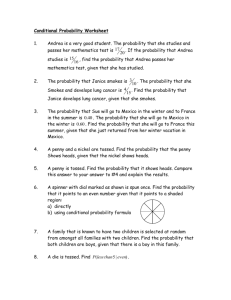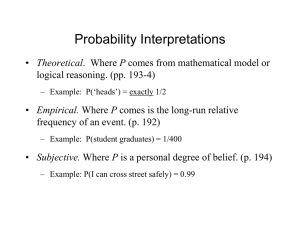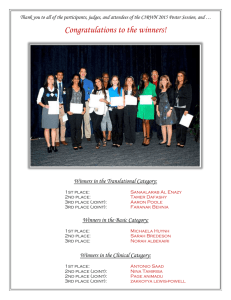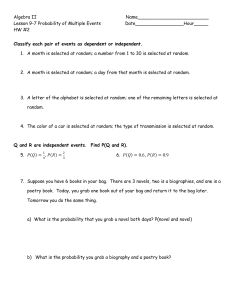Basic Steps for Probability Problems
advertisement
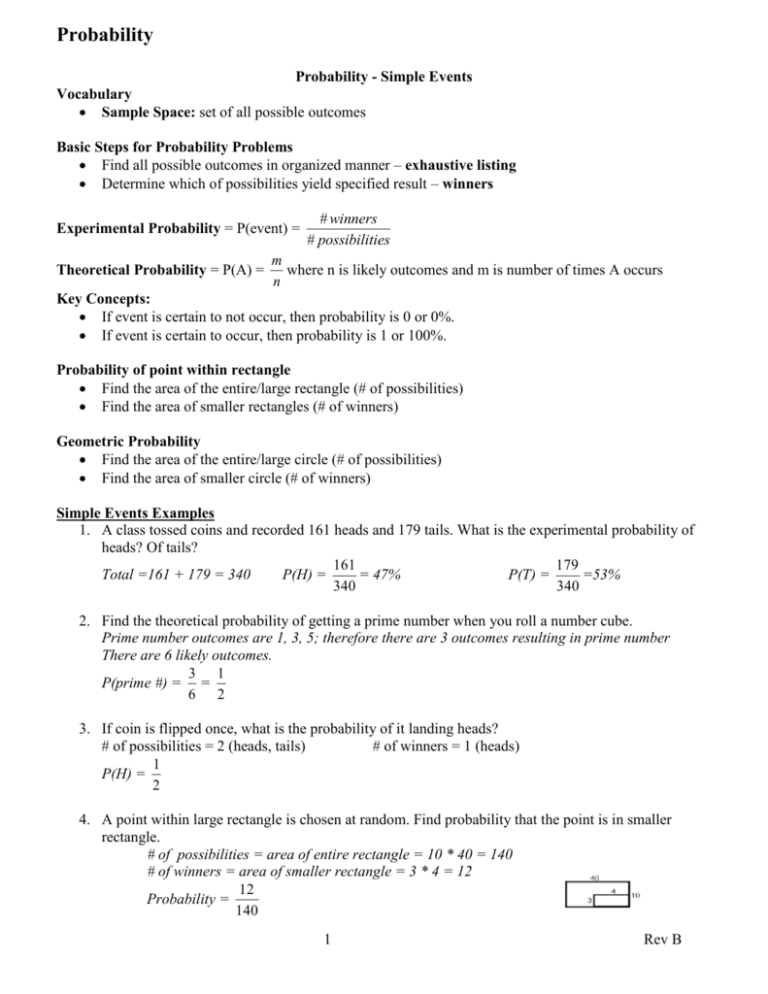
Probability Probability - Simple Events Vocabulary Sample Space: set of all possible outcomes Basic Steps for Probability Problems Find all possible outcomes in organized manner – exhaustive listing Determine which of possibilities yield specified result – winners Experimental Probability = P(event) = Theoretical Probability = P(A) = # winners # possibilities m where n is likely outcomes and m is number of times A occurs n Key Concepts: If event is certain to not occur, then probability is 0 or 0%. If event is certain to occur, then probability is 1 or 100%. Probability of point within rectangle Find the area of the entire/large rectangle (# of possibilities) Find the area of smaller rectangles (# of winners) Geometric Probability Find the area of the entire/large circle (# of possibilities) Find the area of smaller circle (# of winners) Simple Events Examples 1. A class tossed coins and recorded 161 heads and 179 tails. What is the experimental probability of heads? Of tails? 161 179 Total =161 + 179 = 340 P(H) = = 47% P(T) = =53% 340 340 2. Find the theoretical probability of getting a prime number when you roll a number cube. Prime number outcomes are 1, 3, 5; therefore there are 3 outcomes resulting in prime number There are 6 likely outcomes. 3 1 P(prime #) = = 6 2 3. If coin is flipped once, what is the probability of it landing heads? # of possibilities = 2 (heads, tails) # of winners = 1 (heads) 1 P(H) = 2 4. A point within large rectangle is chosen at random. Find probability that the point is in smaller rectangle. # of possibilities = area of entire rectangle = 10 * 40 = 140 # of winners = area of smaller rectangle = 3 * 4 = 12 12 Probability = 140 1 Rev B Probability Simple Events Practice 5. A bowl contains 12 slips of paper, each with a different name of a month. Find probability that slip selected at random from bowl has name of month that starts with letter J. 6. Suppose that a dart lands at random on the dartboard shown at the right. Find each theoretical probability. a. Dart lands in bull’s-eye. b. Dart scores at least 10 points. c. Dart scores less than 10 points Probability - Multiple Events Dependent Events: Events influence one another. Independent Events: Events don’t influence one another. Find probability of the 1st event, find the probability of 2nd event and then multiply the two together. If A and B are independent events, then P(A and B) = P(A) * P(B) Mutually Exclusive Events: Two events that cannot happen at the same time If A and B are mutually exclusive, then P(A or B) = P(A) + P(B). If A and B are not mutually exclusive, then P(A or B) = P(A) + P(B) – P(A and B) Classify Events Examples – Classify as either dependent or independent 7. Spin a spinner. Then, select a marble from a bag that contains marbles of different colors. 8. Select a marble from a bag that contains marbles of two colors. Put the marble aside, and select a second marble from the bag. Multiple Events Examples 9. If a coin is flipped twice, what is the probability of it landing heads up both times? 1 1 1 1 1 P(heads 1st time) = P(heads 2nd time) = P(heads both times) = * = 2 2 2 2 4 3 1 10. S and T are mutually exclusive events. Find P(S or T) when P(S) = and P(T) = . 5 3 3 1 9 5 14 P(S or T) = + = + = 5 3 15 15 15 11. A standard number cube is tossed. Find the probability of P(4 or even). 1 3 1 3 P(4 or even) = + - = 6 6 6 6 2 Rev B Probability Multiple Events Practice 12. Suppose you roll 2 number cubes. What is probability that you will roll an odd number on one cube and a multiple of 3 on the other cube? 13. S and T are mutually exclusive events. Find P(S or T) when P(S) = 1 6 and P(T) = . 7 10 14. A standard number cube is tossed. Find the probability of P(greater than 1 or less than 5). 3 Rev B

